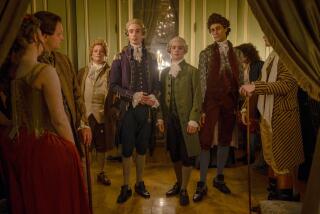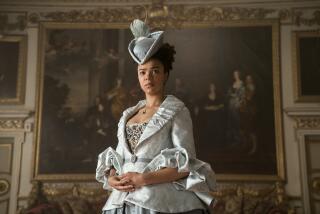Fairest of Pleasures : At the Renaissance Faire, Dressing Up in Elizabethan Costumes Is All Part of the Fun
You can come to the Renaissance Pleasure Faire in your Day-Glo shorts, high-top Nikes, Ray-Ban Wayfarers and Dodgers cap, but it would be a little like attending a Buckingham Palace garden party in a wet suit.
Sure, you can get away with it--most faire-goers come in mufti and get the full Elizabethan thee-and-thou treatment from the costumed cast.
But to get the most out of the faire--which runs weekends from April 20 to June 9--you need to forget that zippers, shoelaces, elastic, Velcro and pockets exist. And you need trot out the roomy muslin, the red brocade, the jerkin with the leather laces, that gaudy velvet hat with the ostrich feathers and that snug bodice that performs functions no Maidenform ever could.
First, however, you have to make a crucial decision: Who wouldst thou be?
In the Elizabethan Age, which included most of the last half of the 16th Century--and is the period in which the Renaissance Faire is set--you could have been anything from a washerwoman or a cobbler to a courtier or a German mercenary. The world knew who you were largely by the way you dressed, and there were three fairly distinct social classes: the nobility, the middle class and the peasants.
But before you watch too many episodes of “Elizabeth R” and decide you were born to wear every bit of noble trapping, there are at least four things to consider: time, skill, expense and the weather.
Assembling a fine courtier’s outfit is a job for someone who is no stranger to a needle and thread. It will take many hours to complete and can cost hundreds of dollars in materials alone. If it is authentic, it would have kept the wearer warm in the cold dampness of England; you, however, will be wearing it in San Bernardino County in late April through early June, and the sun can be relentless.
But if you’ve already grown a spiffy Vandyke beard and you’ve been wearing Levi’s to work for a year to save up for this one big sartorial splash, here are your options if you intend to be:
THE NOBILITY
If you’re a man, you’re a dandy, a fop, a peacock, an unrepentant, unashamed clotheshorse. If you’re a woman, you imitate the queen. Both sexes dress in fine silk, brocade, tapestry, velvet, taffeta, damask, fine wool and gabardine, all in bright colors. There is much embroidery, crewel work, applique, quilting, tucks, braid, buttons and lace for trimming. Both sexes wear a lot of jewelry, such as rings over gloves and heavy gold chains.
In the days of yore, shirts for men were long-sleeved and roomy, with blouson sleeves and the fabric of the body either gathered into a yoke at the neck or allowed to hang straight. The upper classes used ruffs at the neck and wrists.
Over the shirt, most noblemen wore a doublet, a form-fitting coat that fitted more snugly as the man’s station in life rose. Shoulder epaulets concealed where the sleeves were tied on. Some noblemen wore a jerkin--in this case, simply a doublet without sleeves.
Slops (called pumpkin pants by the faire’s official costumers) had panes, or strips of contrasting material, laid over the fabric of the short inner breeches. Men usually stuffed them with straw, wool or silk to make them stand out. They look best when made with good-quality, medium-weight fabrics. The panes can be made of wool, velveteen, corduroy, brushed denim or a blend.
Men’s hose of the period can be simulated with tights. The effect will be more pronounced if ribbon-like garters are tied around the knees.
For women, the shift was the basic garment for all classes. With this went various underpinnings such as petticoats, bum rolls around the waist and drawstring corsets. The bodice was flat across the front and could have a high neck or a low, square one. Neck and wrist ruffs were common. Ornate hats with veils covering highly braided and decorated hair were the rule.
THE MIDDLE CLASS
These people often were merchants, skilled craftspeople or prosperous farmers, and many had aspirations to higher stations in life. They dressed accordingly: The clothes were similar to that of the nobility, but of plainer and more practical fabric.
Rather than fancy slops, men might have worn breeches (roomy knickers gathered below the knee) and high socks rather than hose. Their jerkins and doublets would be plainer, but with fancy touches here and there that elevate them above the peasants.
Women wore practical clothing similar to peasant dress but attempted to imitate the lines of the clothing of court women. Skirts were worn with petticoats for fullness. And like the men, women in the middle class adorned their clothes with fine embroidery and other fancy work.
THE PEASANTS
With the exception of the court, clothing from this class is the most popular with the paid cast at the faire, said costume coordinator Liz Mitchell. The outfits are easier to make, they’re more comfortable, and, in the sometimes blistering heat, they’re blessedly cool.
A peasant man wore a shirt or shift and breeches. He might have worn a leather jerkin with thong laces, a straw or cloth baker’s hat, a belt and knee socks. The poorest wore long pajama-type pants cross-gartered from the knee to the ankle.
Women wore a plain inner skirt and a finer outer skirt of a solid natural color, which she would have pulled up to keep it out of the mud. A shift and a plain bodice, possibly with tied-on sleeves, might have been worn. Plain aprons were common, as were baskets that acted as a kind of peasant purse.
Unbleached muslin is a popular fabric for both men’s and women’s peasant costumes.
CHILDREN
The simplest rule of all: Elizabethan children, regardless of class, dressed in exactly the same style as their parents.
ACCESSORIES
* Hats: Everyone wore one, regardless of class, and it was the part of the costume that most revealed one’s station. Nobles wore a variety of soft and hard hats, often decorated with plumes or jewels. The easiest to make is the Elizabethan flat cap, which can be striking in velveteen.
Middle-class and peasant hats can be made of felt or natural straw (many modern wide-brimmed straw hats are suitable) and decorated with ribbons and feathers. Peasant and some middle-class women often wore a cloth cap, called a biggins, that was much like a baby’s bonnet, and peasant men and women both wore a type of floppy cloth cap much like a modern baker’s hat.
* Shoes: Often a tricky item, but oxfords, clogs, loafers or plain pumps can be made to look upper-class Elizabethan by fitting them with shoe roses or looped bows of ribbon or leather strips with a fancy button in the middle. Sandals were worn by the peasant class only.
A popular alternative for almost all classes is the “kung fu”-type cloth shoe available at many discount shoe stores. “They’re perfect, either in the solid or the Mary Jane style,” said Mitchell, “and we highly encourage them.” Or, said Mitchell, if “you get a high-top Indian moccasin pattern and cut off the fringe, . . . you’ve got a perfectly good boot.” A mistake: high heels on women’s shoes. “They’re not period and they’re very uncomfortable with all the walking you’ll be doing,” said Mitchell.
* Waist wear: Elizabethans had no pockets. They carried their money and other small items in a leather or cloth pouch that hung from their waists, usually tied to a belt. Peasants and craftsmen hung the tools of their trade from their waists as well--spoons for cooks, hammers for silversmiths and the like. “Whatever is hanging off your belt, that’s what you are,” said Mitchell. And everyone wore a drinking vessel suspended from the waist. An inexpensive pewter tankard is a good bet.
* Hand wear: Close-fitting long leather gloves can be found at fencing (the sport) supply stores or can be made by extending deerskin garden gloves with a longer flap of deerskin over the forearm.
* Weapons: Although swords and daggers were common accessories and may be worn at the faire, the blades must be tied fast to the scabbards and not unsheathed at any time. Faire officials check for this at the gate.
WHERE TO GET IDEAS
Faire costumers suggest thrift stores for hard-to-find items such as wide belts and the garment district for good deals on fabric.
There are many books in public libraries that provide details and examples of Elizabethan clothing, as well as art books featuring the highly applicable works of Breugel and Holbein. And the Living History Centre, which presents the Renaissance Faire, offers a free costume brochure at its headquarters at the faire site, 2555 Devore Road, San Bernardino. The brochure also is available from House of Fabrics stores.
The faire costumers’ bible is “Elizabethan Costuming for the Years 1550-1580” by Janet Winter and Carolyn Savoy (Other Times Publications, Oakland, 1983). It is sold at the faire.
COMFORT AND DEPORTMENT
* Bring sun block and use it. You’ll be outdoors for hours.
* Don’t use synthetic fabrics for your costume: They don’t breathe.
* Wear your costume a few times around the house for a while to get used to it. “This is the most important thing,” said Phyllis Patterson, the originator of the faire. “If you spend some time in the clothing of another time, you receive an insight as to why the people behaved the way the did.”
* Learn to speak Elizabethan. Shakespeare is recommended reading for cast members, particularly “The Merry Wives of Windsor.”
* Know thyself. If you’re a dirt farmer, don’t act like a prince. If you’re a courtier, don’t say, “Hey, dude.”
“You can take it on the level of eat, drink and be merry and not see it as anything except a great party,” said Patterson, “or you can really look at what’s happening in any number of environments, from the court on down. You can spend the day with any of them and be totally entertained.”
IF YOU GET STUCK
Don’t call faire officials just to chat; they’re getting ready for the faire, too, after all. But if you feel you’re hopelessly wandering in building your costume, they’ll help steer you straight. Call (800) 52-FAIRE.
FAIRE BASICS
The Renaissance Pleasure Faire started in 1963, when founder Phyllis Patterson was teaching junior high school drama and history in Culver City. That year, she directed a summer drama program called “From Ritual to Broadway” for 100 children. A year later, the 10-year-olds who had been cast in the Commedia del Arte segment of the program asked Patterson to find a way for them to perform again, outdoors on their players’ wagon.
Patterson set the play in a marketplace environment and called it the Renaissance Pleasure Faire. The participants in that first faire, which eventually numbered more than 6,000, agreed to repeat it every year.
Since then, Patterson has spearheaded the Living History Centre, the nonprofit organization that operates the faire and is dedicated to presenting a living pageant of Elizabethan England both in Southern California and in Novato in Northern California.
* Faire days: Eight weekends and Memorial Day from April 20 to June 9. Hours: 9 a.m. to 6 p.m.
* How to get there: San Bernardino Freeway (10) east from Los Angeles to Highway 15 north to Highway 215 south, exit at first off-ramp. Follow signs to parking areas (parking, $3).
* Tickets: Adults, $14.50; children ages 3-11, $7.50 (children under 3 are free); students, seniors and military with ID, $11.50. Fairever (season) pass, $75. Available by telephone and at the gate. Call (800) 52-FAIRE or (714) 880-4241 for information.
* Activities: Lots of hearty food and drink, archery, crafts and music.
* Costumes: Competition will be held May 5. Costumes will be judged in adult peasant, adult middle-class, adult nobility, children of all rank and Shakespeare’s fantasy figures and fools. Judging, scheduled at 2:30 p.m. at The Mayflower stage, will be based on authenticity, color choice, trim design, accessories, fit and finish. Registration deadline is May 4. More details are available from the Special Events Department of the Living History Centre, 2555 Devore Road, San Bernardino. Telephone: (714) 880-6211.
More to Read
Sign up for The Wild
We’ll help you find the best places to hike, bike and run, as well as the perfect silent spots for meditation and yoga.
You may occasionally receive promotional content from the Los Angeles Times.






